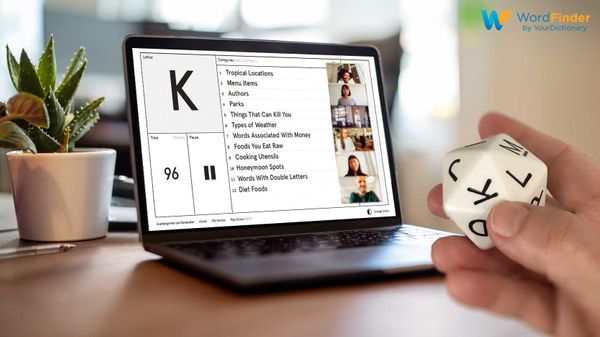Scattergories Rules: Traditional and How to Play on Zoom

Adapted from Getty Images
Basic Scattergories Rules
The basics of how to play Scattergories involve coming up with unique answers. The game presents a list of categories and a random letter. Each player must then come up with responses starting with that letter that fit each of the categories. Scattergories is best enjoyed with two to six players.
Setting Up a Scattergories Game
The following set of Scattergories rules assumes you’ve purchased a retail version of the game. However, once you know how to play Scattergories, it’s easy enough to play the game with regular pads of paper and a little help from the internet. Our friends at LoveToKnow have great suggestions for Scattergories lists to add to your game.
Organize the category cards into sets. Each set should have one copy of every category list.
Give a cardboard folder and an answer sheet to each player, plus a pen or a pencil.
Slide a set of category cards under the left clip of each cardboard folder.
Place an answer sheet under the right clips of each cardboard folder.
Ensure you have a letter die and a timer.
If you run out of answer sheets, regular plain or lined sheets of paper will do just fine. Simply divide each sheet into three lists with 12 numbered spaces each.
Scattergories Gameplay
A standard Scattergories game consists of three rounds. When following the normal Scattergories rules, each round is three minutes long.
Decide on a category list. Make sure every player is looking at the same list in their folder.
Roll the letter die to determine the starting letter. The standard 20-sided die has every letter of the alphabet except Q, U, V, X, Y and Z.
Start the timer. If you’ve misplaced the timer, use a stopwatch or a timer app on your smartphone.
Fill in the first column on your answer sheet. Your answers must start with the letter determined by the letter die. They must also correspond with each of the 12 categories on the category list. For example, if the letter is B, and the category is cities, you might write Boston or Barcelona. Only enter one answer per line.
Everyone must stop writing when time runs out. You can choose to score each round as you go or score all three rounds at the end of the game.
Start the next round by rolling a new letter and starting the timer. Keep using the same category list as you did for the first round. Re-roll if the same letter comes up twice.
Fill in your answers for the second round in the second column, and your third round answers in the third column.
Scattergories Scoring Rules
Remember that the goal of Scattergories is to come up with original, unique answers. Remember to do your best as a word finder to choose different responses than the other players.
Players take turns reading out their list(s) of answers.
If an answer matches one of yours, cross it out on your list.
When everyone finishes reading out their lists, circle the answers that you did not cross out.
You earn one point for every valid, circled answer.
Tally up your points. The player with the most points after three rounds wins.
Optionally, you may reward bonus points for alliteration. For example, if the category is “microwave food” and the starting letter is P, you may earn three points for “Pillsbury Pizza Pops.” Establish whether this rule is in play before you start the first round.
Valid Answers in Scattergories
Every valid response must start with the correct letter. That’s the most basic of Scattergories rules. In determining what is and what isn’t a valid answer, keep the following guidelines in mind:
You cannot give the same answer more than once per round. If you already answered CHINA for “countries,” you can’t also answer CHINA (as in dishware) for “in the kitchen.”
Generally ignore articles (a, an, the) at the beginning of titles. The first letter of The Lord of the Rings is L, not T.
The first letter of a proper name can be the given name or the surname. For example, “Tom Cruise” is a valid response for actors starting with T or C.
Players can challenge answers, just like how you can challenge a word in Scrabble. Every player, including the one with the challenged answer, votes on whether the response is valid or not. If there is a tie, ignore the vote of the player whose answer was challenged.
Creative answers may be acceptable. If a player answers “Westeros” for “country,” other players may challenge that answer. Westeros is a fictional place and not a “real” country. If the majority of players agree Westeros is acceptable, then the answer is valid. This is not as strict as finding words in a Scrabble dictionary.
How to Play Scattergories on Zoom
Just because you can’t get together in person doesn’t mean you can’t play Scattergories with other people. It just means you need to adapt the rules to fit the situation, just as you might with spoken word games you play with friends and loved ones.
Multi-person video chat, like through Zoom or Messenger Rooms, can bring everyone closer together. It takes a bit of getting used to, but Zoom Scattergories can be just as fun as in-person Scattergories.
Adapting Scattergories Rules for Virtual Play
In terms of how to play Scattergories on Zoom, you’ll need to make a few small adjustments to the game.
Every player will need a mobile device or a computer with a webcam to participate in the Zoom video call.
Every player will also need their own pad of paper, plus a pen or pencil. They could type out their answers instead, too. It’s up to you!
Designate one player as the host. This person will manage categories and timers.
Use an online Scattergories list generator, like the one at Swellgarfo.com. The host can share their screen on Zoom.
Add or remove categories before you start playing, if desired. There’s a “make child-friendly” option if you have younger players.
The list generator also selects a letter at random. Tap on “re-roll” for a new letter.
Swellgarfo.com has a built-in timer function too. The default setting is 120 seconds per round, but you can change that.
When you’re ready to start the first round, click “play.” The timer starts automatically.
When you click “reset” or “restart,” you get a new letter and a new set of categories for the next round.
If you want to keep the same categories, click on “re-roll” for a new letter. You will need to use something else for your timer.
Alternatively, if you’d rather not play Scattergories on Zoom, you can also play Scattergories online at scattergoriesonline.net. Create a new game on the site. Then, invite your friends by sharing the provided link. Of course, you can always set up a video call on the side to go along with playing on the website too!
A Creative Competition
Word games like Scattergories are not just great for testing your vocabulary. They also foster a bit of friendly competition. Once you’re done playing Scattergories online or in person, keep that competitive word-gaming spirit alive by reading up on Scrabble rules that will help you win. Snag that bingo bonus with prefixes and suffixes galore!
Michael Kwan is a professional writer and editor with over 14 years of experience. Fueled by caffeine and WiFi, he's no stranger to word games and dad jokes.



